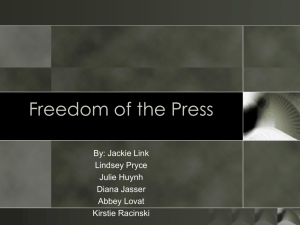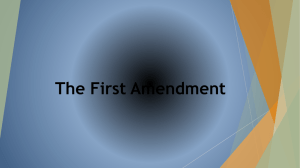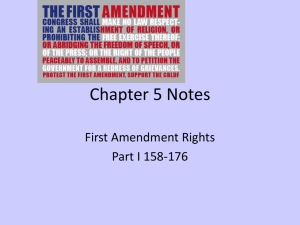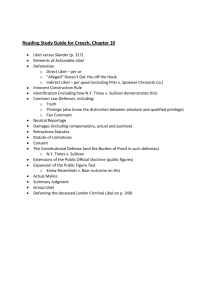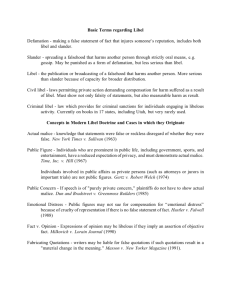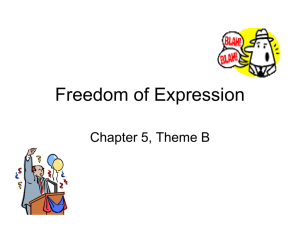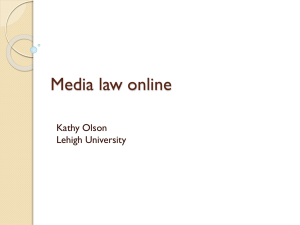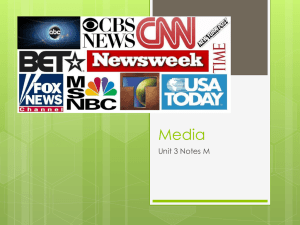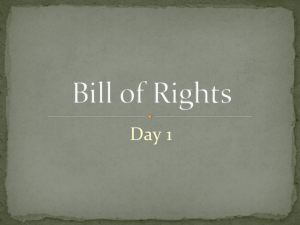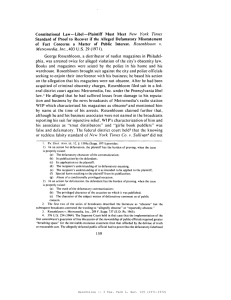Teachers, Students & the First Amendment
advertisement
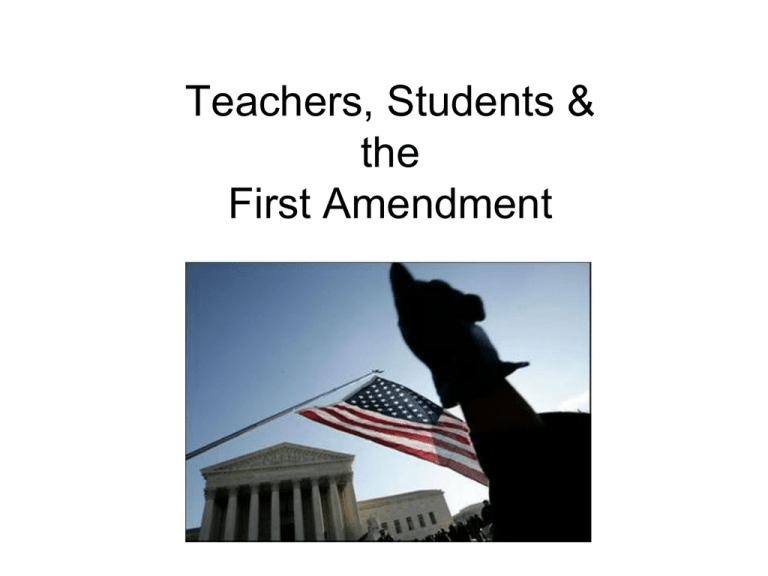
Teachers, Students & the First Amendment The First Amendment (1791) Three “R’s” of the First Amendment • Rights – Individual (Each of us is born with certain inalienable rights) • Responsibilities – Mutual (Each of us must accept the responsibility to guard the rights of others – especially those with whom we most deeply disagree) • Respect – Universal (Each of us must commit to debate out differences with respect). How Important is Free Press? • “If it were left to me to decide whether we should have a government without a free press or a free press without government, I would choose the latter.” – T. Jefferson Do students in public schools have First Amendment rights? Yes No It depends Yes…But Not Until Recently • 1791: “Congress shall make no law…” • 1908: Students suspended for poem critical of their teacher – “Such power is essential to the preservation of order, decency, decorum, and good government in the public schools.” • 1925: Gitlow vs. New York – First Amendment applies to states via the Fourteenth Amendment The Fourteenth Amendment (1868) • Section 1 – No State shall make or enforce any law which shall abridge the privledges and immunities or citizens of the United States; nor shall any state deprive any person of life, liberty, or property, without due process of law; nor deny to any person within its jurisdiction the equal protection of the laws. The Tinker Standard • Tinker vs. Des Moines School District (1969) • Black armbands in 1965 • Student speech cannot be censored as long as it does not “materially disrupt class work or involve substantial disorder or invasion of the rights of others.” The Fraser Standard • Bethel School District vs. Fraser (1986) • Inappropriate speech for class president • Because school officials have an “interest in teaching students the boundaries of socially appropriate behavior,” they can censor student speech that is vulgar or indecent, even if it does not cause a “material or substantial disruption.” The Hazelwood Standard • Hazelwood School District vs. Kuhlmeier (1988) • Censor stories in student newspaper about teen pregnancy and divorce • Censorship of schoolsponsored student expression is permissible when school officials can show that it is “reasonably related to legitimate pedagogical concerns.” The Frederick Standard? Morse vs. Frederick (June 25, 2007) • January 2002, Olympic torch travels through town • Principal Morse cancels school • Senior Frederick unveils banner on the sidewalk across street which reads “Bong Hits 4 Jesus” • Suspended for 10 days How Would You Decide This Case? • What is your reasoning for Frederick? • What is your reasoning for Morse? • Which previous cases do you use for your argument? Your Rights Outside of School • “There is no legal justification for censoring a student’s expression in the privacy of his home.” • For instance, a federal district court in Maine ruled in Smith v. Klein (1986) that school officials violated the constitutional rights of a student when they suspended him for gesturing at a teacher with his middle finger raised at an off-campus restaurant. The judge determined that the student’s disrespectful act was “too attenuated” with school functions to be punishable by school officials. • Similarly, the 2nd U.S. Circuit Court of Appeals rejected school officials’ attempts to shut down an underground student newspaper sold off campus in Thomas v. Bd. of Ed., Granville Cent. Sch. District (1979), writing: “our willingness to defer to the schoolmaster’s expertise in administering school discipline, rests, in large measure, upon the supposition that the arm of authority does not reach beyond the schoolhouse gate.” • Likewise, a federal district court in Washington ruled in Emmett v. Kent School District No. 415 (2000) that student Internet speech created off campus is “entirely outside of the school’s supervision or control.” Three Types of Student Web Sites • Sites that are offensive, obnoxious and insulting • Sites that are offensive, obnoxious and insulting, and also contain some sort of veiled threat of violence or of destruction of property • Sites that contain outright blatant threat (Post Columbine) • Facebook issues at Eden Prairie and and Woodbury High Schools. What are your opinions? Libel and Slander • Libel and slander are legal terms for false statements of fact about a person that are printed, broadcast, spoken or otherwise communicated to others. Libel generally refers to visual or written statements, while slander refers to verbal statements. The term defamation covers both libel and slander. For a statement to be defamatory, it must be more than insulting or offensive. It must actually harm the reputation of another person. • New York Times Co. v. Sullivan (1964) • 1960 New York Times ran a full page add about Martin Luther King and an Alabama tax evasion charge • Libel about the Alabama police force • Commissioner Sullivan requested a retraction and eventually sued, winning $500,000 Elements of Libel • • • • • A defamatory statement… Published to at least one other person (other than plantiff)… “Of and concerning” the plaintiff (identify specifically with plaintiff) That is a false statement of fact (opinions are not libel)… And made with fault. The level of fault depends on status of plaintiff – Public Figures: celebrities, government, etc. are required to prove actual malice, meaning the defendant know statements were false – Private Individuals: must only show that the defendant was negligent, (failing to act with due care). • Libel cases are civil law and may be heard by juries. Monetary damages can be received as compensation for suffering. Ethics • Should we believe everything we see on the news? • How can the news be tainted or falsified? • “Wag the Dog” and course conclusion
